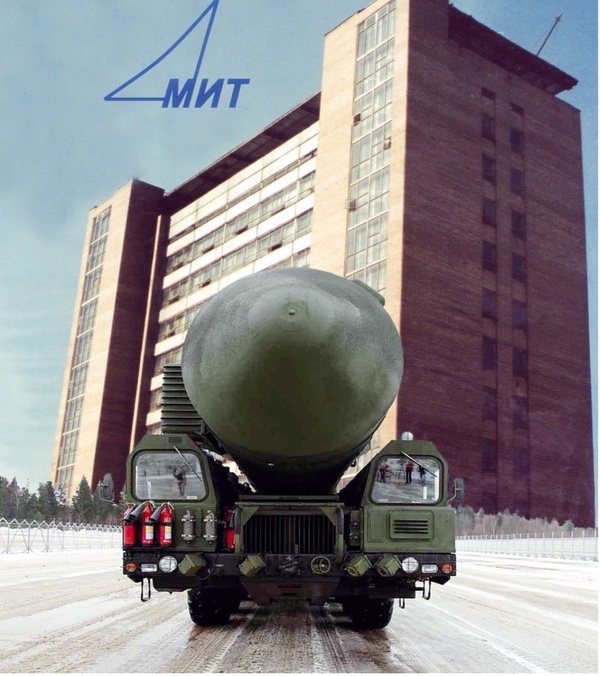 The MIT Corporation is the manufacturer of the Aerostat missile. Composite image showing MIT’s headquarters in Moscow and one of its road-mobile ICBMs. (Source) The MIT Corporation is the manufacturer of the Aerostat missile. Composite image showing MIT’s headquarters in Moscow and one of its road-mobile ICBMs. (Source) |
Aerostat: a Russian long-range anti-ballistic missile system with possible counterspace capabilities
by Bart Hendrickx
Monday, October 11, 2021
Russia has been working for several years on a long-range anti-ballistic missile system named Aerostat. The fact that it is being developed by the country’s sole manufacturer of solid-fuel intercontinental ballistic missiles suggests that it may very well have a range allowing it to double as a counterspace system. The oddly named ABM system (“aerostat” is a general term for unpowered balloons and airships) has never been mentioned in the Russian press or openly discussed by Russian military analysts, but its existence and basic design features can be determined through open-source intelligence.
| There has been much debate over whether Nudol is primarily an anti-missile system with a complementary counterspace role or vice versa. |
Aerostat has shown up in a number of openly accessible official documents, the first being the 2013 annual report of the Almaz-Antey Air and Space Defense Corporation, established in 2002 to unify dozens of companies producing missiles, anti-aircraft systems, radars, naval artillery, and other systems.[1] As can be learned from other publicly available documents, Almaz-Antey was assigned prime contractor for the project by the Ministry of Defense on July 12, 2013. A court document published last July literally describes the purpose of the July 2013 contract as “the development of a long-range intercept complex for the anti-missile defense of the Russian Federation in the period 2013-2018” and identifies the missile as 106T6.[2] Aerostat is not the first such long-range ABM system developed under the supervision of Almaz-Antey. Another one, named Nudol, has been undergoing test flights for several years and is likely seen primarily as a direct-ascent anti-satellite weapon.
Nudol
Nudol (also known as 14Ts033) is named after a small place some 100 kilometers northwest of Moscow that was one of the deployment sites for the long-range missiles of Moscow’s former A-35M missile defense system. Its main element is a road-mobile solid-fuel rocket called 14A042, developed by OKB Novator in Yekaterinburg. This company belongs to Almaz-Antey and has produced a wide range of surface-to-air and cruise missiles. US intelligence data indicate that the 14A042 missile has flown at least ten test flights from the Plesetsk launch site in northwestern Russia since 2014, but no targets seem to have been involved in any of those.
There has been much debate over whether Nudol is primarily an anti-missile system with a complementary counterspace role or vice versa. US intelligence considers it a direct-ascent anti-satellite system, as is clear from statements placed on the website of US Space Command following the latest two Nudol tests in April and December 2020.[3] It has also been characterized as an anti-satellite system by at least two Russian officials, namely the deputy head of a Ministry of Defense research institute and Russia’s deputy Prime Minister Yuri Borisov.[4] Another factor pointing in the direction of an ASAT role for the 14A042 missile is that the 14A designators are typically used for space launch vehicles (for instance, 14A14 is the Soyuz-2 rocket.) 14A042 is indeed termed a “rocket for space-related purposes” in two official documents that outline safety precautions that need to be taken when the rockets fly over the Nenets Autonomous District east of Plesetsk.[5] Moreover, one court document mentions communications systems needed to connect Nudol with the headquarters of Russia’s space surveillance network in Noginsk-9 (code-named 3006M.)[6]
An analysis of online procurement documents shows that Almaz-Antey was named prime contractor for the project by the Ministry of Defense on August 10, 2009, and awarded a contract to OKB Novator for the development of the 14A042 rocket on the same day. For some reason, Almaz-Antey received a new contract for the project on April 10, 2015.[7]
While OKB Novator is responsible for integrating the rocket, the individual stages are manufactured by NPO Iskra in Perm. The designators 14D807 and 14D809 seen in some documents are likely the ones used for the first and second stage.[8] Nudol appears to have a kinetic kill vehicle that contains a “multispectral electro-optical homing head” (MOEGSN or 14Sh129) developed by KB Tochmash.[9] The State Institute of Applied Optics (GIPO) supplies what is called a “combined frameless television/infrared channel” for 14Sh129.[10] This part of the payload, apparently named TTPS, is presumably described in several technical articles published by GIPO, where the spectral ranges are given as 0.4–0.7 microns (visible) and 3.0–5.0 microns (mid-infrared.)[11] Both KB Tochmash and GIPO also have a role in the air-launched Burevestnik ASAT system.
Aerostat’s organizational background
Almaz-Antey’s main subcontractor for Aerostat is the MIT Corporation (MIT standing for “Moscow Institute of Thermal Technology”), which specializes in solid-fuel intercontinental ballistic missiles. Unlike OKB Novator, it is part of the Roscosmos State Corporation and is a newcomer to the field of anti-ballistic missile defense.
After the break-up of the Soviet Union, the MIT Corporation fielded the Topol-M, YARS, and Bulava ICBMs (the latter a submarine-launched missile.) In the 1990s, it also converted Soviet-era Topol ICBMs into space launch vehicles called Start and Start-1, which were used to launch a number of small satellites into low Earth orbit between 1993 and 2006. The company is also working on the solid-fuel emergency escape system for Russia’s new piloted spacecraft Oryol.
Other subcontractors that can be identified from online sources are:
– KB Tochmash and GIPO: the two companies play the same role as in Nudol, providing the electro-optical system of the missile’s homing head. Actually, some procurement documents indicate that the system is identical or at least very similar to the MOEGSN/14Sh129 system carried by Nudol’s 14A042 rocket.[12] It also includes a diode-pumped laser rangefinder.[13] KB Tochmash has also built laser rangefinders for some of its surface-to-air missiles and several years ago was planning to deliver a laser rangefinder “for spacecraft dockings” to an unidentified foreign partner, most likely China.[14]
– NPTsAP imeni N.A. Pilyugina (further referred to here as the Pilyugin Center): this company produces guidance and control systems for launch vehicles and most likely performs the same task for Aerostat. It has built a test stand called Aerostat that is almost certainly intended for the project.[15]
– GOKB Prozhektor: a company belonging to the MIT Corporation that builds autonomous power supply systems for the corporation’s ICBMs. Aerostat is listed among other MIT Corporation missiles in two of the company’s annual reports.[16]
– PAO Radiofizika: a company under Almaz-Antey, involved among other things in building ground-based radar systems that provide targeting data for anti-missile systems. Aerostat is mentioned in PAO Radiofizika’s annual reports for 2018 and 2019 and in a book dedicated to the company’s 55th anniversary. The 2020 annual report mentions work related to “Product 103T6”, an index similar to 106T6. It is not clear if this is yet another missile or whether there is a typo in one of the two indexes.[17]
– GosNIIAS (State Research Institute of Aviation Systems): this appears to build one or more test stands for Aerostat, including one used to simulate the infrared background against which the missile’s homing head will have to track its targets.[18]
– ÐО VIKor: a company that provides technical support and consulting for various military projects. Its website mentions work done in 2019 on research projects called Aerostat-Ts-MIT and Aerostat-S-MIT-Nadyozhnost (the latter word meaning “reliability”).[19]
Technical features
Aerostat may have been discussed in an article written by Almaz-Antey’s deputy general director Pavel Sozinov in a 2017 issue of the corporation’s quarterly journal.[20] It deals with mathematical modeling techniques to simulate the performance of various “air and space defense systems.” One of those is literally called “an advanced long-range intercept complex,” with Sozinov hinting that it has a range considerably exceeding that of existing systems. The simulations were needed to “justify technical decisions made to develop the system” and “determine its combat efficiency.” It can be learned from the article that its targets will be both “complex ballistic targets” (a term usually used for multiple independently targetable reentry vehicles) and satellites (included in the models were “calculations of satellite orbits” as well as data provided by the ground-based space surveillance network.) It cannot be ruled out that Sozinov was writing about Nudol, but he portrayed the research as being linked to a future system, whereas Nudol was already making test flights at the time of writing.
 Pavel Sozinov. (Source) Pavel Sozinov. (Source) |
The computer models simulated the operation of a “central radar complex” to acquire and track the targets and benefited from experience gathered with a mobile radar system named Demonstrator. This was a truck-mounted phased array radar first demonstrated at various air shows in 2013–2014 and described at the time by PAO Radiofizika’s general director Boris Levitan as a prototype of bigger radar stations needed for space surveillance (although it could also be used for detecting airborne targets.)[21]
| What can be concluded from the available information is that Aerostat’s 106T6 rocket is probably a multistage solid-fuel launch vehicle that inherits elements from one or more of the MIT Corporation’s ICBMs. |
The “central radar complex” could be the Don-2 battle management radar currently used by Moscow’s A-135 anti-ballistic missile system or another one known as 14Ts031 or Object 0746-M that is situated near Chekhov, some 60 kilometers southwest of Moscow. This is a modified version of the Dunai-3U radar complex originally built for the earlier A-35M missile defense system and consists of a transmitting and a receiving antenna separated by about three kilometers. In documentation it is called “a specialized space surveillance radar for the detection and monitoring of small-size space objects”. PAO Radiofizika has been closely involved in modernizing the radar complex since early last decade under a project called Razvyazka. Although the radar system has usually been linked to Nudol, it could obviously support Aerostat as well. According to a brochure distributed by PAO Radiofizika at the recent MAKS-2021 aerospace show near Moscow, the modernization of the radar complex has been completed and the main purpose of the P-band phased array radar is to catalog space objects and detect satellites in high orbits.[22]
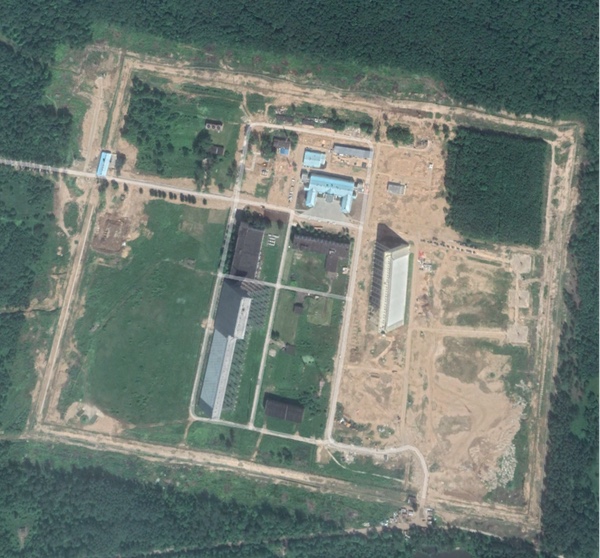 The receiving antenna of the 14Ts031 radar complex is seen on the right side of this image taken from orbit in June 2020. Source: Google Earth. The receiving antenna of the 14Ts031 radar complex is seen on the right side of this image taken from orbit in June 2020. Source: Google Earth. |
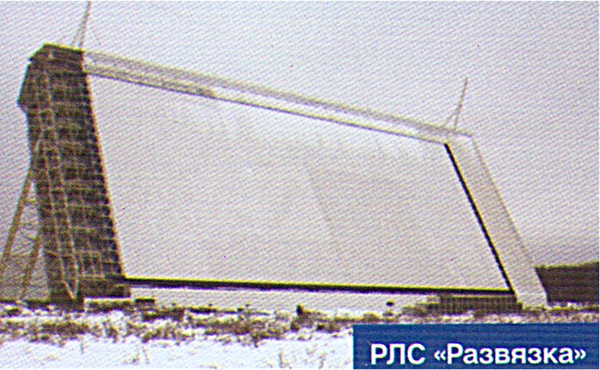 Grainy ground-based picture of the receiving antenna. (Source) Grainy ground-based picture of the receiving antenna. (Source) |
In the same article, Sozinov also discussed techniques to simulate the flight of a multistage solid-fuel rocket carrying a “multispectral electro-optical homing head” (possibly the MOEGSN/14Sh129 system jointly developed by KB Tochmash and GIPO.) He didn’t specifically link the rocket to the “long-range intercept complex,” but the computer models took into account Earth limb background effects, suggesting the rocket is designed to operate outside the Earth’s atmosphere. It has a third stage whose flight path can be corrected using tracking information on the target and its homing head is described as a “two-dimensional tracking system with independent control for each channel” needed to determine the angular velocity of the line of sight. Sozinov’s description of this system is virtually copied and pasted in a paper presented in 2018 by a researcher of the Pilyugin Center (a subcontractor for Aerostat) who has also co-authored several articles as well as a patent on a method to control the thrust of a solid-fuel upper stage.[23] Presumably, targeting data obtained by the sensors will be used by the rocket’s guidance and control system to regulate the upper stage’s thrust.
The link with Aerostat is further supported by the fact that the specific Russian term used for “upper stage” in one of these Pilyugin Center articles (dovodochnaya stupen’, sounding somewhat similar to “kick stage” in English) is seen virtually only in publications of the MIT Corporation. Also, one of the co-researchers, Gennadiy Rumyantsev, is a veteran of the Pilyugin Center who was involved in developing the guidance and control system for the MIT Corporation’s Start launch vehicles back in the 1990s.[24]
These rockets, derived from the Topol ICBM and launched from transporter erector launchers, came in four-stage and five-stage configurations (called Start-1 and Start respectively), with both carrying an additional low-thrust kick stage to deliver the payloads to their final orbits (so strictly speaking they were five-stage and six-stage rockets.) The kick stage had а thrust control system as well as a gas reaction control system to ensure accurate orbital injection of the satellites. In earlier publications, Rumyantsev has pointed out that such kick stages can be used either as an ICBM post-boost stage to deploy nuclear warheads or as the upper stage of a space launch vehicle.[25] Most likely, exactly the same type of stage could be modified to guide an exoatmospheric kill vehicle to its target.
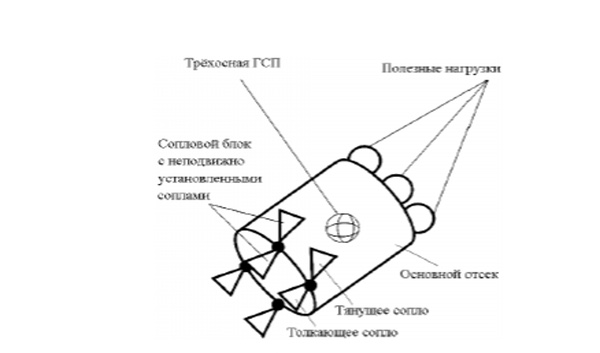 Schematic representation of the Start launch vehicle’s “kick stage”. A similar stage may serve as the basis for Aerostat’s kinetic kill vehicle. (Source) Schematic representation of the Start launch vehicle’s “kick stage”. A similar stage may serve as the basis for Aerostat’s kinetic kill vehicle. (Source) |
The MIT Corporation has recently proposed to revive the Start project using decommissioned Topol ICBMs, at least several dozens of which are left.[26] The renewed interest in Start is also reflected by a handful of patents of the MIT Corporation that have appeared online in recent years.[27] MIT has also studied modified versions of solid-fuel upper stages [28]. Although impossible to prove, it is tempting to believe that these proposals at least partly draw on work done as part of Aerostat since 2013.
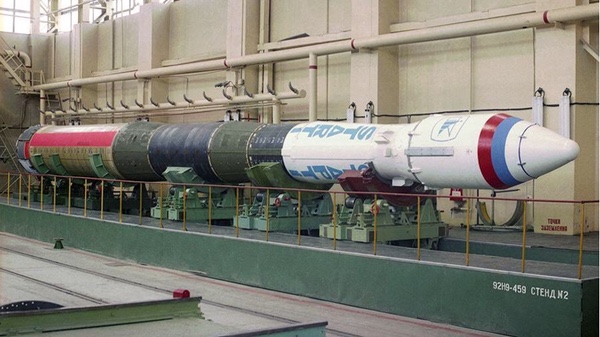 The Start-1 rocket. Source: MIT Corporation. The Start-1 rocket. Source: MIT Corporation. |
Aside from Sozinov’s 2017 article, Almaz-Antey has published two other articles that may be related to Aerostat. One discusses computer simulations of the launch of a “multistage rocket” which “exits the Earth’s atmosphere” and uses both on-board sensors and ground-based radar systems to detect and track its targets. One of its authors has also written an article on modeling the Earth limb’s infrared background radiation as seen by “space-based electro-optical systems.”[29] Considering Almaz-Antey’s background, the research hardly had anything to do with a civilian space project.
| There can be little doubt that Russia considers counterspace weapons an integral part of this system, which is often depicted as being targeted against “air-based and space-based attack systems”. From the Russian perspective, one such potential space-based attack system is the US Air Force’s X-37B spaceplane. |
What can be concluded from the available information is that Aerostat’s 106T6 rocket is probably a multistage solid-fuel launch vehicle that inherits elements from one or more of the MIT Corporation’s ICBMs (Topol-M, YARS, Bulava, or possibly a lightweight version of YARS known as Rubezh.) Judging by Sozinov’s article, it may use the first two stages of an existing ICBM topped by an exoatmospheric kill vehicle consisting of a solid-fuel “kick stage” (the “third stage” mentioned by Sozinov) and a homing system that relies on data fed by ground-based radars and an on-board visible/infrared sensor.
Situating Aerostat in the Russian ABM program
So where does Aerostat fit in Russia’s anti-ballistic missile program? In May 2016, MIT Corporation general director Yuri Solomonov acknowledged his company’s leading role in a missile defense project, but did not provide additional details other than calling it analogous to the American Aegis system.[30] Aegis is the Navy component of the US missile defense system and is geared toward defending against short-, medium-, and intermediate-range ballistic missiles during their midcourse phase. It also has a limited counterspace capability, which was demonstrated in 2008 when an Aegis Standard Missile-3 was used to destroy a derelict US reconnaissance satellite to prevent it from re-entering the atmosphere in one piece and possibly causing harm to people on the ground (or that, at least, was the official explanation.) While Aegis is primarily a sea-based system, it also has a land-based component (Aegis Ashore) which began deployment in Eastern Europe in 2016. This has drawn strong criticism from Russia, which considers it a breach of the Intermediate-Range Nuclear Forces (INF) Treaty, arguing Aegis Ashore can also be used to launch Tomahawk cruise missiles against targets on Russian territory.
Тhe evidence presented above is not consistent with Aerostat being a theater missile defense system like Aegis. Presumably, Solomonov was referring to Aegis as a well-known example of a US missile defense system rather than meaning to say MIT’s missile defense system is in the same category.
 MIT Corporation general director Yuri Solomonov. (Source) MIT Corporation general director Yuri Solomonov. (Source) |
Protection against theater missiles is currently provided by the S-300 and S-400 air defense systems. The only ABM system capable of intercepting ICBMs is A-135, deployed around Moscow to intercept incoming warheads targeting the city and its surrounding areas. This was declared operational in 1995 and is the successor to the original A-35 system deployed in the 1970s in compliance with the 1972 ABM Treaty (which limited both the US and the Soviet Union to having only one ABM site, but was abandoned by the US in 2002.) Currently, A-135’s main elements are the Don-2N battle management phased array radar and several dozen short-range 53T6 (NATO reporting name “Gazelle”) endoatmospheric nuclear-tipped missiles developed by OKB Novator. Also part of A-135 was 51T6 (NATO reporting name “Gorgon”), a long-range nuclear-tipped exoatmospheric missile, which has now been retired.
In 2014, Almaz-Antey’s Pavel Sozinov said that Russia’s missile defense system was being considerably upgraded and would comprise equivalents of America’s THAAD and GMD systems. THAAD (Terminal High Altitude Area Defense) is intended to intercept short- and medium-range missiles at the end of the midcourse stage and in the terminal stage of flight. GMD (Ground-Based Midcourse Defense) is designed to counter ICBMs in the midcourse stage. According to Sozinov, the THAAD-type system would target medium-range ballistic missiles and have a limited capability against ICBMs as well. The other system would be “somewhat similar to GMD”, but would be mobile and have a “higher intercept efficiency.” [31] In 2017, the chief designer of Russia’s missile early warning system, Sergey Boyev, declared that a “multi-layered national missile defense system” would be deployed by 2025, calling it a response to the “direct threat” posed by the US Aegis Ashore missiles deployed in Eastern Europe.[32]
There can be little doubt that Russia considers counterspace weapons an integral part of this system, which is often depicted as being targeted against “air-based and space-based attack systems”. From the Russian perspective, one such potential space-based attack system is the US Air Force’s X-37B spaceplane, which, according to Sozinov, could carry up to three warheads into space and then deliver them to their targets after evading early warning systems.[33] Even President Vladimir Putin himself has alluded to the offensive potential of the X-37B, saying that “re-usable shuttle type spacecraft” can give the US an edge in the militarization of space and that the deployment of what he called “combat complexes” in orbit poses a greater threat to world security than that of medium-range missiles in Europe[34]. In 2017, Sozinov acknowledged Almaz-Antey’s involvement in the development of counterspace weapons, more particularly electronic warfare systems to be used against radar reconnaissance, optical reconnaissance, and communications satellites, as well as systems for “the direct functional destruction of elements deployed in orbit,” an apparent reference to kinetic ASAT weapons.[35]
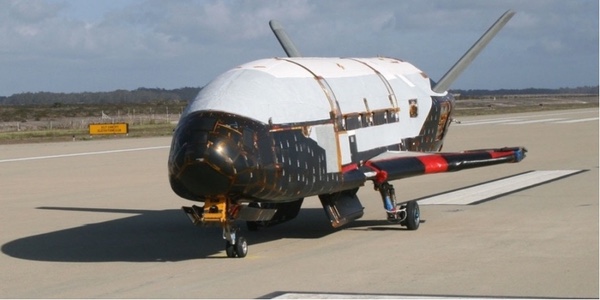 The US Air Force X-37B is seen by Russia as a potential “space-based attack system”. Source: USAF. The US Air Force X-37B is seen by Russia as a potential “space-based attack system”. Source: USAF. |
What Sozinov called “the Russian THAAD” appears to be the S-500 system (also known as Prometey and Triumfator-M). As explained by Sergey Surovikin, the commander of the Russian Aerospace Forces, the S-500 system is aimed against both “aerodynamic targets” (including drones and hypersonic vehicles) and “ballistic targets.” Its main goal, he said, is to destroy medium-range ballistic missiles, but if needed it can also intercept ICBM-launched warheads in the terminal stage. He added that, in the future, it will also be able to destroy low orbiting satellites and “space-based attack systems.”[36] Little has been revealed about S-500, but available information suggests that it includes the 40N6M missile (with a reported range of 400 kilometers) for use against aircraft and cruise missiles and the more powerful 77N6-N and 77N6-N1 (with an estimated range of 500–600 kilometers) to counter ballistic missiles and satellites. All these missiles are products of MKB Fakel.
| If used in an ASAT capacity, Aerostat should have a range considerably higher than that of Nudol and, hence, be capable of taking out satellites in higher orbits. |
The “Russian GMD” is most likely the upgraded Moscow ABM system known as A-235. Work on this began back in 1991 under the strange code-name “Samolyot-M” (“samolyot” means “aircraft”), but progress has been very slow. The short-range component of A-235 appears to be an improved variant of OKB Novator’s 53T6 missile called 53T6M, which has been making test flights from the Sary-Shagan test range in Kazakhstan since early last decade. The long-range component, the replacement for the decommissioned 51T6, has long been rumored to be Nudol, with numerous sources (including Wikipedia) going as far as claiming that Nudol actually is another name for the entire A-235 system (which is clearly not the case.) In reality, there is no convincing documentary evidence that Nudol will become part of A-235.
The index used for Aerostat’s missile (106T6 or possibly 103T6, the same nomenclature as 53T6 and 51T6) does point to it being a future element of A-235. It would have several advantages over 51T6. Likely having a longer range, it would be able to intercept ICBMs earlier in the midcourse phase than has been possible so far. Rather than being installed in silos, it should be mobile (the MIT Corporation’s ICBMs can be launched from transporter erector launchers) and its advanced homing system should allow it to kinetically destroy its targets instead of disabling them by detonating a nuclear warhead in their vicinity.
Nudol’s place in all this remains uncertain (its exact range is unknown). Possibly, A-235 will be a three-tier system with short-range missiles (53T6M), medium-range missiles (Nudol/14A042) and long-range missiles (Aerostat/106T6). Original plans formulated for A-235 in the 1990s did in fact call for such a three-tier system. It is also possible that Nudol is a specialized ASAT system with no anti-missile role at all (the 14A042 index of the Nudol missile is not indicative of it being part of A-235).
Possible counterspace role
So is Aerostat designed to attack satellites as well? If Sozinov was writing about Aerostat in his 2017 article, then it would appear it is. The fact that Aerostat and Nudol seem to share the same tracking sensors may also point in that direction. If used in an ASAT capacity, Aerostat should have a range considerably higher than that of Nudol and, hence, be capable of taking out satellites in higher orbits. In the absence of more specific information on the design, it is difficult to estimate exactly how much higher.
As a rule of thumb, the apogee that a ballistic missile can reach when launched vertically is approximately one half of its maximum horizontal range.[37] Therefore, a missile like Topol, which has a horizontal range of around 11,000 kilometers, would be able to reach a maximum altitude of roughly 5,500 kilometers. By replacing the nuclear warheads with a much lighter kinetic kill vehicle and adding one or more stages (as done on the Start rockets), that ceiling can be significantly increased. Recall that China conducted a high-altitude missile test in May 2013 that was officially billed as a scientific sounding rocket mission, but was later assessed by the Pentagon to have been a possible “test of technologies with a counterpace mission in geosynchronous orbit.”
However, it is highly questionable that Aerostat would be able to reach such altitudes or even those used by America’s GPS/Navstar navigation satellites (around 20,000 kilometers.) Moreover, it would take hours for a direct-ascent ASAT weapon to reach such targets, giving them ample time to perform evasive maneuvers. A more efficient way of disabling satellites in such orbits is by using electronic warfare systems, several of which are known to have been deployed by Russia. Any other US military satellites that could be worthwhile targets for anti-satellite systems orbit the Earth no higher than about 1,000 kilometers, more specifically the KH-11 optical reconnaissance satellites, the X-37B spaceplanes, the Onyx (Lacrosse) and Topaz radar reconnaissance satellites, and the NOSS-3/Intruder ocean reconnaissance satellites. Also added to the list could be a series of European military observation satellites. All of these would likely fall within the range of Aerostat.
| Future tests of Aerostat may be complicated by the fact that Russia’s main test range for anti-missile systems (Sary-Shagan) is located in neighboring Kazakhstan. |
In short, within several years Russia may possess as many as three anti-missile systems that could double as direct-ascent anti-satellite weapons (S-500, Nudol and Aerostat), whatever the rationale behind that may be. That goal has, in fact, been officially acknowledged for S-500 and Nudol, with the latter possibly even being a dedicated ASAT system. In addition to those, Russia probably already has operational ground-based electronic warfare and laser systems for counterspace purposes and is also working on co-orbital ASAT systems, which already seem to have made test flights under the Burevestnik and Nivelir projects.[38]
Project status
Some insight into the original test schedule for Aerostat is provided by the earlier mentioned court document published this July. The July 2013 contract between the Ministry of Defense and Almaz-Antey and later supplements to the contract called for finishing the preliminary design by November 2014 and conducting a “live experiment” in October 2017. So-called “preliminary tests” were to be completed by November 2020 and followed by “state tests,” after which the system was to be declared ready for serial production in November 2021.
“Preliminary tests” and “state tests” are terms inherited from the Soviet days denoting the test phases that a military product has to go through before it is declared operational. “Preliminary tests” are defined as tests needed to determine if experimental versions of a military product meet technical specifications. “State tests” are needed to establish whether the product meets technical requirements “in conditions as close as possible to those experienced in the field” and to decide whether it can be approved for operational use and serial production.
According to the document, the “live experiment” was eventually carried out on December 26, 2017. No further details are given, but on that day Russia’s Strategic Missile Forces launched a Soviet-era Topol ICBM on a test flight from the Kapustin Yar test range near Volgograd (most likely toward the Sary-Shagan range in Kazakhstan.) In a statement released the same day, the Ministry of Defense announced the flight was designed to test new ballistic missile defense countermeasures.[39] The same goal has also been reported for other Topol test flights from Kapustin Yar and was not unique to this mission. In this particular case, the test may have been aimed at testing ways of evading countermeasures taken by the enemy to prevent its missiles from being intercepted by ABM missiles. The fact that the Aerostat-related test was carried out with a Topol missile does not at all imply that Aerostat itself will also be based on Topol. The aging Topol missiles are used to demonstrate technology for newer ICBMs.
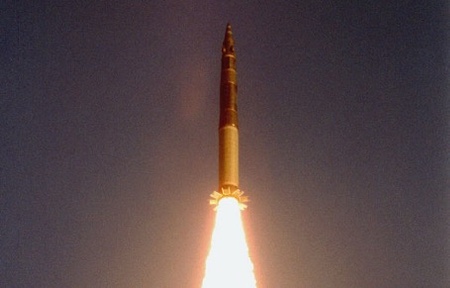 Launch of a Topol missile. (Source) Launch of a Topol missile. (Source) |
The court document does not shed any light on further technical progress made in the Aerostat project after the December 2017 test. The subject of the court case was a lawsuit filed by the Ministry of Defense against Almaz-Antey for delays in the “live experiment” and the delivery of design documentation and software for the project (with the MIT Corporation mentioned only as a third party.) The court also granted a request from the Ministry of Defense to terminate the July 2013 contract, but that does not necessarily mean that the project has been canceled. The contract covered work on Aerostat in the 2013–2018 period and its official termination may have been no more than a bureaucratic move. In fact, procurement documents show that the Ministry of Defense signed a new contract with Almaz-Antey for Aerostat on April 26, 2018 and further work seems to have taken place only under that contract. A similar pattern was seen in the Nudol project, where the government contract with Almaz-Antey was renewed after six years.
The work known to have been performed under the new contract does carry the label “NIR”, which is Russian short for the research phase of a project that precedes actual systems development (referred to as “OKR”.) This may indicate that at least some systems have encountered technical problems that have forced designers back to the drawing boards.
Future tests of Aerostat may be complicated by the fact that Russia’s main test range for anti-missile systems (Sary-Shagan) is located in neighboring Kazakhstan. One anonymous “highly-placed source” in the Russian defense industry told a Russian news outlet in June last year that this is causing problems for tests of long-range air and missile defense systems, particularly S-500. To some extent, the source said, this also applied to Nudol, although the main stumbling block for Nudol were “some unresolved technical issues” that were expected to keep it from entering combat duty until 2021 “at the earliest.”[40] Still, if Nudol and Aerostat have a hit-to-kill capability, that likely would have to be demonstrated before they are declared operational. Russia may prefer to do that using ballistic targets rather than orbiting satellites, considering the vast amounts of space debris that would be generated by such tests. Since it uses the same type of tracking sensors, Nudol could also serve as a pathfinder for Aerostat.
What seems to be a new test range for anti-missile systems (Object 2142) is being constructed near the town of Severo-Yeniseiskiy in the Krasnoyarsk region in Siberia. It is part of a project called Ukazchik-KV, which in one document was associated with “a test range and internal flight path for tests of anti-missile systems and anti-missile countermeasures” (“internal flight path” probably meaning a flight path that doesn’t cross Russia’s borders.)[41] Planned for installation at the new test range are radars and optical tracking systems similar to those used at Sary-Shagan. One map of the test range shows (simulated) warheads coming in from the northwest, indicating the new “internal flight path” will be from Plesetsk to Severo-Yeniseiskiy and complement or replace the currently used flight path from Kapustin Yar to Sary-Shagan.[42] Late last year, Defense Minister Sergey Shoigu said the site near Severo-Yeniseiskiy was needed for tests of the new Sarmat liquid-fuel ICBM, but it clearly will be used for other purposes as well.[43]
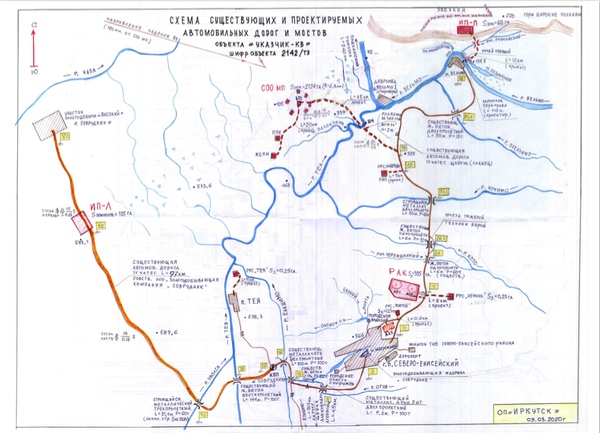 Map of the “Object 2142” test range, scattered over a large area near Severo-Yeniseiskiy. The arrow in the upper left corner indicates the direction of travel of incoming warheads. (Source) Map of the “Object 2142” test range, scattered over a large area near Severo-Yeniseiskiy. The arrow in the upper left corner indicates the direction of travel of incoming warheads. (Source) |
Ukazchik-KV was assigned to Almaz-Antey on the very same day as Aerostat (July 12, 2013), as was yet another missile defense project called Selektsiya, which seems to be aimed at creating an integrated command structure for Russia’s air and missile defense systems. It is not entirely clear though if there is any connection between these three projects, which were initiated under three different government contracts. But even if Aerostat does not need the new test range, it seems to have fallen far behind the schedule originally set out for it and may still be a long way from reaching operational status.
No comments:
Post a Comment